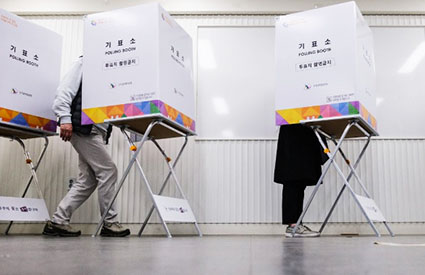by WorldTribune Staff, April 8, 2024
Ahead of South Korea’s general election on April 10, problems with computerized tabulation machines are already being reported.
On April 5, early voting began and “within hours there were numerous complaints of the National Election Commission (NEC) reporting inflated numbers of votes cast at various early voting centers relative to observed voting at the polling locations,” Tara O noted in an April 5 analysis for the East Asia Research Center.
 South Korea will vote Wednesday in key legislative elections that will determine control of the country’s parliament — and whether President Yoon Suk-Yeol can advance his socially conservative agenda. / Anthony Wallace / AFP
South Korea will vote Wednesday in key legislative elections that will determine control of the country’s parliament — and whether President Yoon Suk-Yeol can advance his socially conservative agenda. / Anthony Wallace / AFP“Early voting is an extremely controversial topic in South Korea, along with the use of electronic vote counting machines,” the analysis noted. Many voters “do not trust” this system, especially after the controversial 2020 elections dominated by the leftist ruling party.
Related: Allegations of fraud in South Korean elections called warning on new voting technologies, May 8, 2020
The National Election Commission’s count is displayed on a monitor of a computer that is connected to the NEC’s central server.
The analysis cited an “election observer” in Daegu’s Daemyeong 9-dong Neighborhood who counted 95 voters by 8:10 a.m. on April 5, 2024, and according to lawyer Park Ju-Hyun Park asked the election official on site for the number of votes tallied. The NEC server-connected computer monitor (which is televised for the viewers to see) displayed a different number. The computer monitor showed 137 local resident ballots counted and 30 non-local residents ballots counted, for a total of 167 ballots counted.
“How can this be?” Tara O asked. “167 – 95 = 72 additional ballots. It shows that 72/95 = 76% more ballots counted in the NEC system than the number of voters who actually went to the early voting center.”
The analysis cited an election observer in Seoul's Seongbuk District as saying that he counted the ballots each time a voter placed his/her ballot in the ballot box. Every 1-3 hours, he compared the numbers to the numbers from the NEC server provided to him by the election official on site, and discovered major discrepancies. The observer counted 945 ballots while the NEC computer monitor showed 1,030.
In the Shinjeong 1-dong neighborhood of Nam District in Ulsan City in southeast Korea (near Busan), an election observer noted more discrepancies in the ballot numbers counted. The election observer noted that the NEC server-connected computer monitor showed 40 more ballots counted at 9 a.m., 58 more by 9:30 a.m., and 96 more by 11 a.m.
In Gangseo District in Seoul, an election observer tried to take a photo of a barcode on the ballot (not yet voted) that was missing the numbers below the barcode. The observer noted it as evidence of a strange ballot. An NEC official told the observer that she couldn’t take photos and forced her to leave the premise.
“As she walked out of the building, she asked the policeman who was just outside the early voting station. He checked his cell phone and told her that she needed to leave. She asked to see what he read on the phone. He showed it to her,” Tara O noted. “It said taking photos is a violation of Section 166 of the election law, that taking photos illegally can be fined up to ₩4,000,000 (~$3,000), and that the record of it can prevent employment with the police in the future.”
In her phone conversation with Lee Sang-Ro, a veteran journalist formerly of MBC and a professor, on his YouTube channel, the observer shared what she discovered about the law.
“It turns out that taking photos inside the voting centers, as long as it is not in the voting booth where the actual marking of ballots occurs, is allowed by law, so she did not do anything illegal,” Tara O noted. “Thus, both the NEC official and the policeman removed her from the early voting center by giving her false information.”
Tara O cited other problems with South Korea's voting system:
The early voting ballots will be stored for 4 to 5 days, and the method of transportation for the ballots, the lax security of the storage spaces for the ballots, and what appears to have been tampering with the security tapes on the ballot boxes have been problems in the past, especially in April 2020 when the Democratic Party of Korea, then ruling party, won in a major landslide election.
Furthermore, the National Election Commission had been hacked by North Korea multiple times last year. After the National Intelligence Service notified the National Election Commission of the hacking, it refused inspections and investigations. After a nepotism scandal at the National Election Commission was uncovered, however, it agreed to a limited joint inspection by the National Intelligence Service, Korea Internet & Security Agency (KISA) and National Election Commission. They inspected the National Election Commission system from July 17 – September 22, 2023, and discovered the National Election Commission systems were indeed hackable.
The inspection showed that the ballot count results could be manipulated and there was a risk of a mass leak of voters’ personal information. The inspection showed that attackers were also able to steal the signature-equivalent seals of the National Election Commission (blue seal) and the polling stations’ signature files used on the early voting ballots (which are different than the day-of voting ballots). The National Election Commission repeatedly stated its system is not not able to be hacked, although the evidence show otherwise.
In this year's election, voters will select 300 lawmakers for South Korea’s National Assembly, which is the Korean equivalent of the U.S. Congress.
Source link

